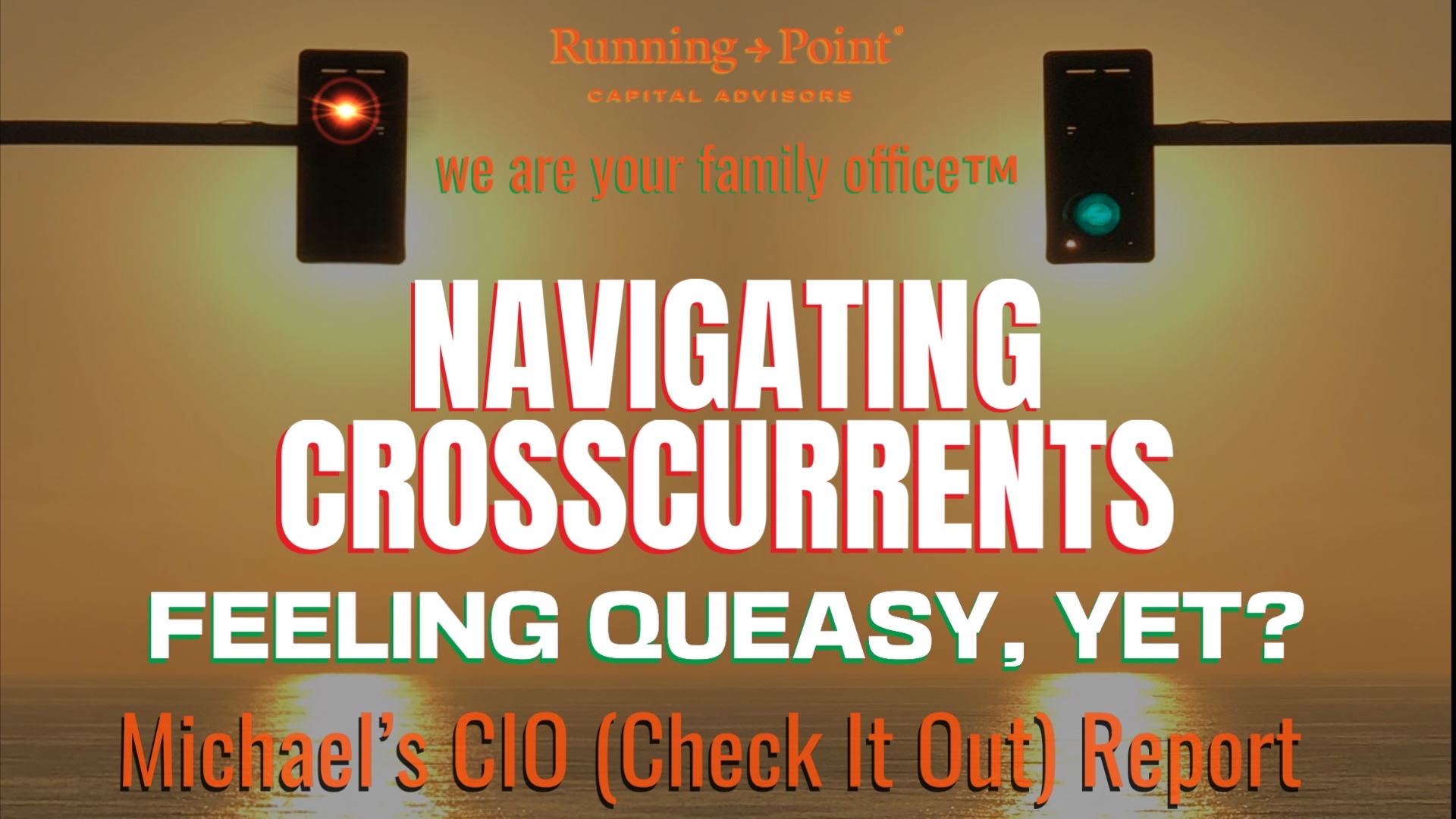Summary
- 2020 has paradoxically been the best and worst year—moods are down, but asset values are up significantly
- Portfolios had a solid year—stocks are up, bonds are up, and real estate did not fall off a cliff—in other words, this was not a repeat of the 2008 great financial crisis
- Our early-in-the year 2020 thesis of bigger, faster, and better defensive and offensive fiscal and monetary stimulus effectively supported asset prices
- Economic cycles seem to be shorter and more intense than in the past; it remains important to position around such cycles, but arguably more important for long-term returns to catch structural tailwinds
- The greatest economic stimulus in 2021 will come from the distribution of the COVID-19 vaccines, which will be a catalyst for the cheapest and best stimulant of all: positive sentiment
- Risks, of course, are ever-present—war, cybersecurity threats, a crisis in China, over-taxation or regulation by government, inflation, virus mutation, vaccine side effects, and mass rental and housing evictions—as is the concern that too many investors may already be positioned for recovery and a synchronized global economic upswing
- Pent-up demand fueled by cheap credit and government stimulus should power economic growth; the world will look better, but in fits and starts

Details
“It was the age of wisdom, it was the age of foolishness, it was the epoch of belief, it was the epoch of incredulity, it was the season of Light, it was the season of Darkness, it was the spring of hope, it was the winter of despair, we had everything before us, we had nothing before us.” In other words, “It was the best of times, it was the worst of times,”[i] or more succinctly, it was 2020.
To say the least, 2020 was a rocky year in numerous ways; many were directly affected by COVID-19 or grieved for those who were. Social and political movements reminded us of how much more still needs to be done. Numerous establishments, especially restaurants, hospitality, entertainment, travel, and a large swath of retail, suffered. But companies in the digital, warehousing, delivery, and home entertainment realms boomed, governments around the globe stepped in with trillions of dollars of safety nets and stimulus, and most businesses accelerated their digital agenda. Our thoughts early in the pandemic that defensive and offensive government stimulus would be huge and that every company will have to be digital have held true.
The messaging around economic cycles seem to be shorter and more intense; there is minimal filter on international communication, commerce, and the widespread distribution of ideas. Getting one’s message out is cheap and gaining attention in a viral world seems faster and easier than ever before. Corporate profits are above where they were at this point last year and returning to pre-pandemic highs. This is very different from a typical cycle where it takes years, not quarters, to recover. Thus, although it is important to position around cycles, it is arguably more important for long-term returns to understand and catch structural socioeconomic tailwinds.
An effective COVID-19 vaccine is great news; multiple vaccines are even better news. Economic recovery carried good momentum going into the fourth quarter and even though a run of government-mandated business shutdowns will slow or reverse progress, this seems truly a case of “darkest before the dawn.”[ii] The impact of the second virus wave on gross domestic product (GDP) will be much smaller than the spring contraction. The new restriction mix favors industry but inevitably hits services (especially hospitality, entertainment, and retail trade) with an extended blow. Undoubtedly, more restaurants and small businesses will go under. The varying stringency of new restrictions across counties and states (as well as globally) perpetuates the geographical divergence in activity and our perception of recovery.
Vaccine optimism will fuel expectations of a synchronized global reacceleration in 2021, with China in pole position after weather int the coronavirus pandemic better than the West. Policymakers in the major advanced economies are unlikely to stand in the way of recovery, keeping an easy policy bias at least until output reaches pre-virus levels. The question for asset markets is whether forward earnings expectations are overly optimistic or pessimistic. We expect that a market scare is likely but hesitate to time price volatility when government safety nets and largesse remain plentiful. History suggests that policymakers’ worries about ballooning budget deficits and rising debt often lead to excessive or abrupt fiscal belt-tightening that stifles growth. Because unemployment is bound to stay elevated while many debt-saddled businesses that have suffered from lockdown restrictions continue to struggle with profitability, fiscal policy is likely to retain an easing bias as the nature of stimulus measures shifts from damage control to nurturing a post-COVID recovery. Ongoing fiscal support underpinned by strong central bank guidance increases the chance that the seeds of global macro reacceleration will flourish.
Janet Yellen’s nomination to head the U.S. Treasury may also be a positive for asset valuations. As head of the Federal Reserve, every time Yellen spoke publicly, stock prices tended to rise. She had a positive and calming influence that favored the economy and veered toward putting more income in consumer pockets. Expect Yellen to lead on more stimulus and allowing Biden to deliver broad economic growth. Additionally, the Fed, led by Jerome “Jay” Powell, has signaled that in sharp contrast to the last economic cycle, it will now take an unemployment rate of sub-4% and an inflation rate of above 2% for it to lift interest rates from the zero bound. This is a strongly accommodative signal that U.S. short-term interest rates are set to remain near zero for a while; recall that the Fed kept rates at zero for seven years in the last cycle.
Overall, we remain relatively positive on U.S. stocks, have begun to think more favorably about emerging market stocks, continue to favor targeted private credit and private real estate exposure, and feel that municipal bonds should hold up relatively well as taxes increase and Treasury interest rates remain near decades lows. For that matter, low interest rates make a lot of assets look attractive as long as they have growth, income, or sustained value.
- The U.S. economic recovery is strong—unemployment has declined to 7%, lower than many predicted—even though almost every sector is in some sort of reorganizational upheaval, digital shift, and virtual adaptation; and unfortunately, some sectors (live entertainment, conferences, travel, restaurants, malls, and offices) remain severely incapacitated
- Real estate will continue to be a mixed bag with demand for housing, industrial and warehouse space strong, malls and shopping centers weak, and offices a big question mark that will vary greatly by location
- In a global twist, the Middle East has become much more important to China than to the U.S. as America has become oil independent while Chinese imports of oil from the region have increased more than 12-fold over the last two decades
- Although trade-war rhetoric may continue, the reality will probably be lighter, as all nations need trade, growth opportunities, and capital flows; nonetheless, China’s recent Regional Comprehensive Economic Partnership will aid its drive to de-Americanize its supply chains and reach President Xi Jinping’s goal of doubling GDP by 2035, helping Taiwan and Korea along the way
The worst thing an investor could have done in 2020 was sell out of investments in March or April and not get back in. In the new year, where appropriate, expect to see: shifts in our emerging market allocations; a desire for direct exposure to individual bonds through our custom fixed income (CFI) accounts; an increased emphasis on our equity custom-designed indices (CDIs) to increase tax loss harvesting efficiencies and personal customization; our continued search for attractive private credit, private real estate, and other illiquid opportunities that may be right for some investors in managing volatility while planning toward long-term goals. To wit, in the words of our Managing Partner, Jim Schlager, expect Running Point to “Lean Forward” in 2021.
Risks, of course, are ever-present. We live on a complicated planet with all kinds of things going on. I am troubled by the fact that too many investment strategists may be on board with the recovery story and a synchronized global economic boom. When everyone is on the same side of the boat, it can easily tip. At some point there will be a miss or a fresh crisis—war, new cybersecurity threats, a watershed moment in China, disincentivizing overtaxation or regulation by government, inflation, virus mutation, or vaccine side effects. Additionally, the looming risk of large-scale homelessness or personal bankruptcy once rent and mortgage moratoriums ends has yet to be addressed. We remain watchful over true potential roadblocks or macro stumbles like these; vaccines are not a panacea for all the world’s ills.
There is potential for a post pandemic roaring 2020s reminiscent of last century’s 1920s. The path is well greased with necessary and sufficient conditions, but there are no guarantees. The 1920s had a series of very pro-business presidential administrations (similar to the recent Trump administration); maybe that pro-business stance will continue under Biden? Similarly, as the world recovered from the trauma of World War I, the U.S. was in a low inflation environment with huge improvements in productivity from assembly lines and new inventions. Many were to own cars, radios, and telephones for the first time. It was the era of Charles Lindbergh and Amelia Earhart, Charlie Chaplin, Duke Ellington, Louis Armstrong and the Jazz Age, women gaining the right to vote, citizenship for American Indians, the Harlem Renaissance, social conflict, Al Capone, Ford surpassing 10 million cars, Babe Ruth, Coco Chanel, Art Deco, and the earliest “talkie” movie—the first words, “You ain’t heard nothing yet.”
Many Americans spent the 1920s in a great mood. Investors flocked to a rising stock market. Companies launched brand-new, cutting-edge products, like radios and washing machines. Exuberant Americans kicked up their heels to jazz music, tried crazy stunts, and supported a black market in liquor after Prohibition. A popular expression of the time asked, “What will they think of next?” –PBS.org[iii]
Similarly, we see huge productivity increases coming with technology being not merely a business sector but also a platform. 5G technology, sensible use of artificial intelligence, and rapid inventiveness from global online learning as well as massive research and development budgets will have real cash flow implications that enable other industries to expand output, change the world of productivity, and improve growth like nothing before. The total addressable market of nearly every business in a more digital world could soar.
The most important consumer product of the 1920s was the automobile. Low prices (the Ford Model T cost just $260 in 1924) and generous credit made cars affordable luxuries at the beginning of the decade; by the end, they were practically necessities. In 1929 there was one car on the road for every five Americans. Meanwhile, an economy of automobiles was born: Businesses like service stations and motels sprang up to meet drivers’ needs. –History.com[iv]
Additionally, we are hopeful for huge macro environmental, social, and governance (ESG) improvements, and an emphasis on impact investing, sustainability, and pollution reduction as this pandemic has reminded consumers, investors, corporations, and governments of our interconnectivity. There will be more demand for enterprises with a purpose that also deliver great jobs and profits—entrepreneurial business models that improve the system. The 1920s experienced a real boom of new ideas and industries. Expect a prosperous decade ahead, albeit with significant whipsaws and surprises.
Next Steps
In ten years, people may reflect on 2020 as a pivotal time of change, productivity expansion, and strength that grew out of our collective tragedies and shutdowns. It is time to start thinking in new ways. U.S. income has grown strongly; consumer debt has been reduced; mortgage rates and servicing costs have been locked in at low levels; savings are up and growing; consumption is strong with pent-up demand; asset wealth has grown; productivity is increasing; the Fed and Treasury are supportive of employment growth; the incoming Biden administration has stated that whatever fiscal measure passes in December (if it passes) will only be a down payment; vaccine distribution may be the largest stimulus yet; and more and more people believe the discount rate will remain low for a long while—we could be teed up for a huge, well-fueled U.S. consumer and corporate comeback—the Roaring 20s (with or without flappers).
Happy new year and new decade,
Michael Ashley Schulman, CFA
Partner, Chief Investment Officer
[i] A Tale of Two Cities by Charles Dickens, published both serially and in book form in 1859. The story is set in the late 18th century against the background of the French Revolution.
[ii] Sharing similarities to “there is light at the end of the tunnel,” this expression has been with us since at least the late 17th century as English theologian and historian Thomas Fuller expresses the sentiment, “It is always darkest just before the day dawneth” in his pre-TripAdvisor travelogue of the Holy Land: A Pisgah-Sight of Palestine and the Confines Thereof. Note, in the Book of Deuteronomy, Pisgah is the top of the mountain that God ordered Moses to climb shortly before his death so as to see the Promised Land. https://www.bookbrowse.com/expressions/detail/index.cfm/expression_number/582/its-always-darkest-before-the-dawn
[iii] PBS.org, American Experiences, https://www.pbs.org/wgbh/americanexperience/features/crash-roaring-20s/
[iv] History.com, https://www.history.com/topics/roaring-twenties/roaring-twenties-history
Disclosure: The opinions expressed herein are those of Running Point Capital Advisors, LLC (“Running Point”) and are subject to change without notice. Running Point reserves the right to modify its current investment strategies and techniques based on changing market dynamics or client needs. This should not be considered investment advice or an offer to sell any product. Running Point is an independent investment adviser registered under the Investment Advisers Act of 1940, as amended. Registration does not imply a certain level of skill or training. More information about Running Point, including our investment strategies, fees and objectives can be found in our ADV Part 2, which is available upon request. RP-20-38


